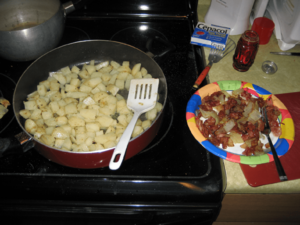Sautéing facts for kids
Sautéing is a quick way to cook food. It uses only a little bit of fat in a flat pan. The pan needs to be very hot. Food for sautéing is often cut into small pieces or thin slices. This helps it cook faster.
When you sauté, the food gets a nice brown color. It also keeps its natural texture, moisture, and flavor. If you sauté meat or fish, you can sometimes use what's left in the pan to make a tasty sauce.
Contents
What is Sautéing?
Sautéing is a cooking method where you cook food quickly over high heat with a small amount of fat. The word "sauté" comes from the French word sauter, which means "to jump." This describes how the food is often tossed or "jumped" in the pan.
Sautéing vs. Pan-Frying
People sometimes mix up sautéing and pan-frying. But they are a bit different:
- Sautéing uses less fat and cooks smaller, thinner pieces of food very quickly.
- Pan-frying usually cooks larger pieces of food, like chops or steaks. It might use a bit more fat than sautéing.
Sautéing vs. Searing
Sautéing is also different from searing. Searing is when you only brown the outside of the food. Sautéing cooks the food all the way through, not just the surface.
Best Fats for Sautéing
Choosing the right fat is important for good sautéing.
- Olive oil is a popular choice for sautéing.
- Clarified butter also works very well.
- Most other cooking fats can be used too.
Why Clarified Butter is Better than Regular Butter
Regular butter can add a lot of flavor to your food. However, it burns more easily than other fats. This is because regular butter contains milk solids. These milk solids burn quickly at high temperatures. Clarified butter has had these milk solids removed, so it can handle higher heat without burning. This makes clarified butter a better choice for sautéing.
Images for kids
-
Leeks being sautéed
-
Sautéed mushrooms: baby Bella (portobello) mushrooms being sautéed
See also
 In Spanish: Salteado para niños
In Spanish: Salteado para niños







